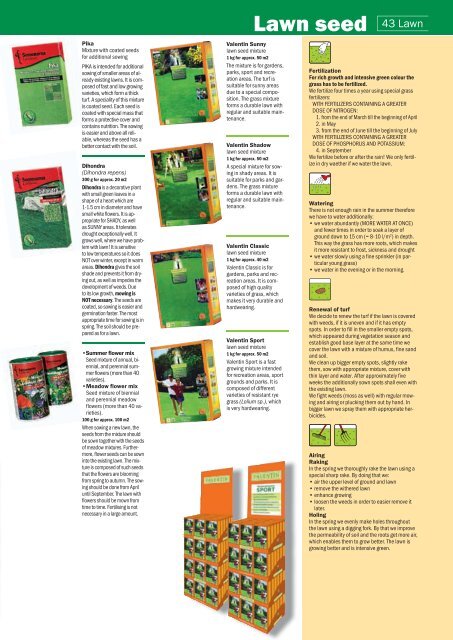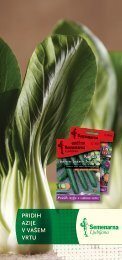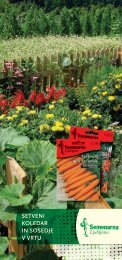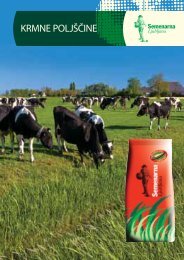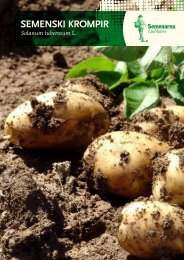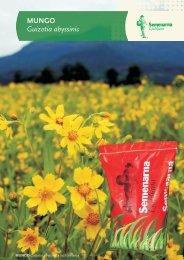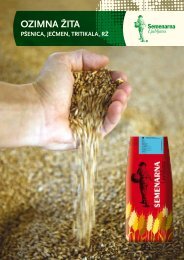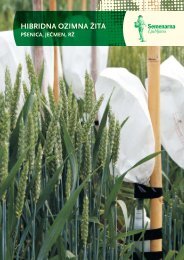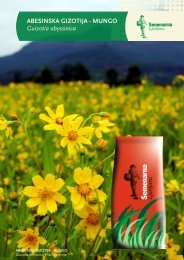katalog_ENG_20080221.indd 1 2/26/08 3:26:36 PM - Semenarna ...
katalog_ENG_20080221.indd 1 2/26/08 3:26:36 PM - Semenarna ...
katalog_ENG_20080221.indd 1 2/26/08 3:26:36 PM - Semenarna ...
You also want an ePaper? Increase the reach of your titles
YUMPU automatically turns print PDFs into web optimized ePapers that Google loves.
Pika<br />
Mixture with coated seeds<br />
for additional sowing<br />
PIKA is intended for additional<br />
sowing of smaller areas of already<br />
existing lawns. It is composed<br />
of fast and low growing<br />
varieties, which form a thick<br />
turf. A speciality of this mixture<br />
is coated seed. Each seed is<br />
coated with special mass that<br />
forms a protective cover and<br />
contains nutrition. The sowing<br />
is easier and above all reliable,<br />
whereas the seed has a<br />
better contact with the soil.<br />
Dihondra<br />
(Dihondra repens)<br />
300 g for approx. 20 m2<br />
Dihondra is a decorative plant<br />
with small green leaves in a<br />
shape of a heart which are<br />
1-1.5 cm in diameter and have<br />
small white flowers. It is appropriate<br />
for SHADY, as well<br />
as SUNNY areas. It tolerates<br />
drought exceptionally well. It<br />
grows well, where we have problem<br />
with lawn! It is sensitive<br />
to low temperatures so it does<br />
NOT over winter, except in warm<br />
areas. Dihondra gives the soil<br />
shade and prevents it from drying<br />
out, as well as impedes the<br />
development of weeds. Due<br />
to its low growth, mowing is<br />
NOT necessary. The seeds are<br />
coated, so sowing is easier and<br />
germination faster. The most<br />
appropriate time for sowing is in<br />
spring. The soil should be prepared<br />
as for a lawn.<br />
• Summer flower mix<br />
Seed mixture of annual, biennial,<br />
and perennial summer<br />
flowers (more than 40<br />
varieties).<br />
• Meadow flower mix<br />
Seed mixture of biennial<br />
and perennial meadow<br />
flowers (more than 40 varieties).<br />
100 g for approx. 100 m2<br />
When sowing a new lawn, the<br />
seeds from the mixture should<br />
be sown together with the seeds<br />
of meadow mixtures. Furthermore,<br />
flower seeds can be sown<br />
into the existing lawn. The mixture<br />
is composed of such seeds<br />
that the flowers are blooming<br />
from spring to autumn. The sowing<br />
should be done from April<br />
until September. The lawn with<br />
flowers should be mown from<br />
time to time. Fertilising is not<br />
necessary in a large amount.<br />
Lawn seed<br />
Valentin Sunny<br />
lawn seed mixture<br />
1 kg for approx. 50 m2<br />
The mixture is for gardens,<br />
parks, sport and recreation<br />
areas. The turf is<br />
suitable for sunny areas<br />
due to a special composition.<br />
The grass mixture<br />
forms a durable lawn with<br />
regular and suitable maintenance.<br />
Valentin Shadow<br />
lawn seed mixture<br />
1 kg for approx. 50 m2<br />
A special mixture for sowing<br />
in shady areas. It is<br />
suitable for parks and gardens.<br />
The grass mixture<br />
forms a durable lawn with<br />
regular and suitable maintenance.<br />
Valentin Classic<br />
lawn seed mixture<br />
1 kg for approx. 40 m2<br />
Valentin Classic is for<br />
gardens, parks and recreation<br />
areas. It is composed<br />
of high quality<br />
varieties of grass, which<br />
makes it very durable and<br />
hardwearing.<br />
Valentin Sport<br />
lawn seed mixture<br />
1 kg for approx. 50 m2<br />
Valentin Sport is a fast<br />
growing mixture intended<br />
for recreation areas, sport<br />
grounds and parks. It is<br />
composed of different<br />
varieties of resistant rye<br />
grass (Lolium sp.), which<br />
is very hardwearing.<br />
43 Lawn<br />
Fertilization<br />
For rich growth and intensive green colour the<br />
grass has to be fertilized.<br />
We fertilize four times a year using special grass<br />
fertilizers:<br />
WITH FERTILIZERS CONTAINING A GREATER<br />
DOSE OF NITROGEN:<br />
1. from the end of March till the beginning of April<br />
2. in May<br />
3. from the end of June till the beginning of July<br />
WITH FERTILIZERS CONTAINING A GREATER<br />
DOSE OF PHOSPHORUS AND POTASSIUM:<br />
4. in September<br />
We fertilize before or after the rain! We only fertilize<br />
in dry waether if we water the lawn.<br />
Watering<br />
There is not enough rain in the summer therefore<br />
we have to water additionally:<br />
• we water abundantly (MORE WATER AT ONCE)<br />
and fewer times in order to soak a layer of<br />
ground down to 15 cm (= 8-10 l/m 2 ) in depth.<br />
This way the grass has more roots, which makes<br />
it more resistant to frost, sickness and drought<br />
• we water slowly using a fine sprinkler (in particular<br />
young grass)<br />
• we water in the evening or in the morning.<br />
Renewal of turf<br />
We decide to renew the turf if the lawn is covered<br />
with weeds, if it is uneven and if it has empty<br />
spots. In order to fill in the smaller empty spots,<br />
which appeared during vegetation season and<br />
establish good base layer at the same time we<br />
cover the lawn with a mixture of humus, fine sand<br />
and soil.<br />
We clean up bigger empty spots, slightly rake<br />
them, sow with appropriate mixture, cover with<br />
thin layer and water. After approximately five<br />
weeks the additionally sown spots shall even with<br />
the existing lawn.<br />
We fight weeds (moss as well) with regular mowing<br />
and airing or plucking them out by hand. In<br />
bigger lawn we spray them with appropriate herbicides.<br />
Airing<br />
Raking<br />
In the spring we thoroughly rake the lawn using a<br />
special sharp rake. By doing that we:<br />
• air the upper level of ground and lawn<br />
• remove the withered lawn<br />
• enhance growing<br />
• loosen the weeds in order to easier remove it<br />
later.<br />
Holing<br />
In the spring we evenly make holes throughout<br />
the lawn using a digging fork. By that we improve<br />
the permeability of soil and the roots get more air,<br />
which enables them to grow better. The lawn is<br />
growing better and is intensive green.<br />
<strong>katalog</strong>_<strong>ENG</strong>_<strong>20<strong>08</strong>0221.indd</strong> 43<br />
2/<strong>26</strong>/<strong>08</strong> 3:37:41 <strong>PM</strong>


